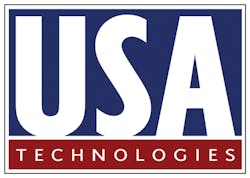Burch Food Service Expands Relationship With USA Technologies; Sees One-Year 17% Topline Growth In Transaction Dollars
Source USA Technologies, Inc.
MALVERN, Pa.--(BUSINESS WIRE)-- USA Technologies, Inc. announced the initial results of an expanded agreement with Burch Food Service (Burch), a Canteen franchisee.
Over the last 30 years Burch Food Service has grown to become one of the country's premier independently owned foodservice and vending providers, with operations spanning Missouri, Arkansas, Tennessee, Kentucky and Illinois. USAT is currently upgrading more than 1,000 of the company's machines to its state-of-the-art cashless technology platform and telemetry services, enabling the company to track the acceptance of cash, credit/debit cards, and contactless payments, including mobile wallet payments such as Android Pay and Apple Pay, through its NFC-capable ePort Connect® cashless payment system. With the deployment nearly complete, Burch, based on a recent one-month study, reported cashless usage at 31 percent for existing machines and 26 percent for new machines. Burch also reported a 17 percent topline growth in transaction dollars on machines connected to USAT devices between June, 2015 and June, 2016.
"As more consumers demand card and mobile payment capabilities at point-of-sale, expanding our partnership with USAT to add cashless to every machine enables us to offer the most superior payment options to our consumers," said Steven Burch, President and CEO, Burch Food Services. "Over the years we have established a reputation for offering the best products and most innovative solutions to our clients, providing the best possible consumer experience. Our goal is to ensure we are doing it in the most effective, efficient way that drives usage and increases revenues. We are already seeing the benefits of cashless through increased cashless sales, and we expect this upward trend to continue as we move toward completing the deployment."
As part of the agreement, Burch has signed up for USAT's Premium Support Service offerings, which provides customers access to a bundle of best-in-class support services including deployment planning, project management, installation support, training, tools specific to the marketing of cashless programs, and marketing support/consultation, mobile payment and loyalty programs and, in some cases, funding support.
With USAT's backing, the Burch team took an aggressive and collaborative approach to the marketing of their newly enhanced program from an overhaul of the company's website, to a strategic communication plan for the new payment options using USAT's Go Cashless program, an educational, point-of-sale marketing program designed to help operators effectively roll out cashless transaction technology. USAT believes that, through these efforts, Burch was able to cut the adoption curve for the new technology. Typically it takes 18 months for an unattended operation to get new equipment to 28 percent cashless. Within five months of deployment, the average monthly cashless usage at Burch's equipment is at 26 percent.
Burch also worked with USAT to enable campus card acceptance at a local university - adding acceptance for closed-loop campus ID cards running on the Blackboard system to allow purchases at Burch's on-campus vending machines. Now in addition to cash, machines on campus accept campus cards, credit and debit cards, as well as mobile payments. Following conversion of those on-campus machines to accept additional payment methods, and based on early studies, average cashless usage was at 51 percent.
"We believe that Burch has built its reputation and business by focusing on the needs of its clients and consumers with smart, innovative solutions, and this deployment is no exception," said Michael K. Lawlor, Chief Services Officer, USA Technologies. "From the beginning, we worked in partnership with Burch to ensure the deployment was strategic, and we saw very good results on many machines. By using our Go Cashless marketing program, taking advantage of our premium services offerings and extending payment solutions to campus cards, Burch is offering its customers a seamless payment experience. The company is a great example of how an unattended operation can transition to 100 percent cashless on machines that can be configured to accept cashless devices the right way."





